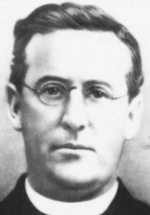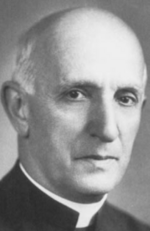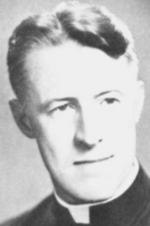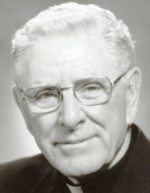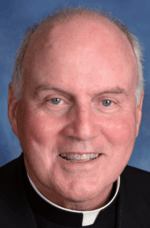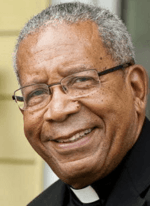Josephites (Maryland) facts for kids
|
Societas Sodalium Sancti Joseph a Sacra Corde
|
|
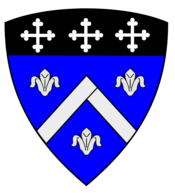 |
|
| Abbreviation | SSJ |
|---|---|
| Nickname | Josephites |
| Formation | May 30, 1893 |
| Founders | John R. Slattery Charles Uncles John A. Deruyter Dominic Manley Lambert Welbers |
| Founded at | Baltimore, United States |
| Type | Society of apostolic life of pontifical right for men |
| Headquarters | 1130 N. Calvert Street, Baltimore, Maryland, United States |
|
Members
|
68 members (58 priests) as of 2020 |
|
Superior General
|
John Huston Ricard, SSJ |
|
Ministry
|
Sacramental, Educational and Pastoral |
|
Parent organization
|
Catholic Church |
The Society of Saint Joseph of the Sacred Heart, often called the Josephites, is a group of Catholic men. They are based in Baltimore, Maryland. Their special mission is to serve and support African Americans in the United States. Members of this group use the letters SSJ after their names.
The Josephites started in 1893. They were formed by priests from the Mill Hill Missionaries who worked with Black people who had recently gained freedom after the American Civil War. Among the founders were Father John R. Slattery, who became their first leader, and Father Charles Uncles, one of the first Black priests in the nation. With permission from their leaders in England and the Archbishop of Baltimore, the Josephites became an independent group. They were fully dedicated to helping the African-American community.
The Josephites have served in Black Catholic churches, schools, and other ministries across the country. They also played a big part in the Black Catholic Movement in the late 1900s. This movement helped Black Catholicism become a more important part of the larger Black church. The Josephites also helped bring back the role of permanent deacons in the United States. Bishop John Ricard, a Josephite, helped start the National Black Catholic Congress in 1987.
In 2011, the Josephites chose their first African-American leader, Father William "Bill" Norvel. He also started a special center for new members in Nigeria. The next two leaders have also been African Americans, including Bishop Ricard. As of 2021, most of the new Josephite priests and students are from Nigeria.
Contents
History of the Josephites
Early Years and Freedom (1865–1869)
The year 1865 marked the start of the Reconstruction era in the Southern United States. During this time, the Thirteenth Amendment to the United States Constitution was passed, which made slavery illegal. Former Confederate states had to agree to the Fourteenth Amendment to the United States Constitution. This amendment gave citizenship to everyone born in the U.S., no matter their race.
In 1869, Catholic bishops in the U.S. met in Baltimore, Maryland. They decided that churches should provide missions and schools for all Black Americans. Education was seen as a very important need for the community.
Because of this, the bishops asked Father Herbert Vaughan for help. He was the leader of the Mill Hill Fathers in London. He had started his group in 1866. Vaughan later became a very important leader in the Catholic Church.
Starting in America (1870–1893)
Father Vaughan brought some of his priests to Baltimore in 1871. They came to serve the newly freed Black people. Many bishops in the U.S. did not have enough priests or programs for Black Catholics. The Mill Hill Fathers often helped fill this need. They would lead churches, staff schools, and start missions to welcome new members.
In 1893, Father John R. Slattery, a leader of the Mill Hill Fathers in the U.S., asked for a change. He wanted the priests in the U.S. to form their own American group. This new group would continue to focus on helping African Americans. They would teach the Catholic faith and promote the Church’s ideas about social justice. The plan was approved. A small number of priests joined to form the Josephites.
Early Challenges and Father Uncles (1893–1933)
Father Charles Uncles was one of the first Josephite priests in 1893. He was the first African-American priest ordained in the U.S. He faced many difficulties because of unfair treatment. Some people did not want Black priests in their churches or communities. This made it hard for Father Slattery's dream of many Black priests to come true.
Instead, Black priests like Father Uncles often traveled to preach in the Deep South. They also had smaller roles in churches or taught at the Josephite seminary in Washington, D.C.. Meanwhile, the white Josephite priests continued to expand their work across the country.
John Henry Dorsey, SSJ, became the second Black priest ordained in America in 1902. He helped start the Knights of Peter Claver in 1909. Sadly, he died tragically in 1923.
Epiphany Apostolic College opened in 1925. It was a school for younger students who wanted to become Josephite priests. In the same year, the Josephites helped start Xavier University of Louisiana. This was the only Black Catholic university in the nation at that time. The Josephites became a special type of Catholic society in 1932.
Father Slattery eventually lost hope because of the unfair treatment he saw. He left the priesthood and the Catholic faith. He became a successful lawyer. Father Uncles died in 1933, still feeling frustrated by the challenges he faced.
Growth and Continued Challenges (1933–1950)
After the early experiences, some Josephite leaders were careful about accepting Black candidates. They accepted a few, but mostly avoided the question of Black priests.
Black Catholics, like Thomas Wyatt Turner, noticed this. They put pressure on the Josephites to change. This pressure did not have a big effect for many years. However, the Josephites continued to grow in members and in managing churches.
Louis Pastorelli, a long-serving Josephite leader, continued the policy of limiting Black candidates. But he did support other groups' efforts to train Black priests. For example, he supported the Society of the Divine Word in starting a seminary for Black priests in Mississippi. This seminary quickly produced new Black priests who were well-received.
As more Catholic groups began to accept Black candidates, the Josephites slowly became more open. In the 1940s, Josephite leader Edward V Casserly made official policies to allow more Black applicants. During this time, the Josephites also added 20 churches and 20 schools. This included St. Augustine High in New Orleans, an all-Black school.
Civil Rights and Black Power (1950–1971)
As more Black priests joined, some Josephite members worried about the group changing. One leader even tried to stop Black applications. But Casserly quickly stopped this unfair policy. Even so, Casserly's leadership ended in 1948. His successor, Thomas P. McNamara, continued to expand Josephite work and welcome Black students.
After years of progress, the end of the Civil Rights Movement brought new challenges. The death of Martin Luther King Jr. highlighted issues of racism. This led many Black religious leaders to commit to social justice and Black Power.
In April 1968, the first meeting of Black Catholic clergy took place in Detroit. They stated that the Catholic Church in America was "primarily a White, racist institution." This led to calls for more Black freedom and expression in the Church. It also caused tension, including at St Joseph's Seminary in Washington, D.C.
The minor seminary in New York closed around this time. In 1971, Black people protested at St Joseph's Seminary. Many students left, and the school stopped offering academic studies that year. However, the building is still used for housing and holds the Josephite archives and other important offices.
Some of the demands made during this time were met. For example, the role of the permanent deacon was brought back. This was largely due to a Josephite priest who focused on the African-American community.
After this period, Josephite students began to study at other universities. The Josephites also used Xavier University of Louisiana, which they helped found, as a school for younger students.
Modern Era of the Josephites
In the 1980s, Father William Norvel was a leader for the Josephites. He is known for starting Catholic gospel choirs in Washington, D.C., and Los Angeles. These choirs brought more Black expression into church services. In 1987, Josephite Bishop John Ricard started the National Black Catholic Congress. This was a new version of an older movement from the late 1800s.
In June 2011, about 130 years after their founding, the Josephites elected Norvel as their first Black leader. Both of the leaders who followed him have also been Black, including the current leader, Bishop Ricard.
Josephites in Nigeria
Father Norvel also started a Josephite center in Nigeria. He lived there for five years. Now, most of the new Josephite members come from Nigeria. The Josephites have a school for younger students there. In 2021, they welcomed about a dozen new students. Their Nigerian students get their first college degrees in Nigeria. Then they come to the Catholic University of America in the United States for more studies.
New Headquarters
St Joseph's Manor, where the Josephite leaders used to live, was sold in 2019. The leaders now live and work in a shared building nearby. This building has been the Josephite headquarters since about 2016.
Organization and Members
The Josephite society runs 34 churches in 12 different areas. They also run St. Augustine High School in New Orleans, Louisiana. This is a historic school for Black boys, started by the Josephites in 1951.
Their main office is in northern Baltimore. Their building for students and retired priests, St. Joseph Seminary, is in Washington, D.C..
In 2012, the Josephites had 40 houses and 88 members, including 76 priests. In late 2020, they had 60 members.
The Josephite Harvest Magazine
The Josephite Harvest is the official magazine of the Josephites. It is the oldest Catholic missions magazine still being published in the U.S. It started in 1888 as The Colored Harvest. In 1960, its name changed. For many years, the magazine shared stories about the Josephites' work. It showed how they built churches and schools for African Americans across the country.
Today, the magazine is published four times a year. You can read it as a physical magazine or online.
St Joseph's Seminary
St Joseph's, the Josephite seminary, is in Brookland, Washington, D.C. This area is known for its many Catholic institutions.
Even though the seminary stopped offering academic classes in 1971, it still houses Josephite students during the school year. It also provides homes for retired Josephite priests and other residents all year long.
The seminary building was added to the National Register of Historic Places in 2022.
Archives
The Josephite archives are also in this building. These are very important records of African-American history in the country. A Josephite priest used to manage them. After he passed away, a lay archivist took over. This person greatly improved how the records are organized and made them easier for researchers to use.
Pastoral Center
The Josephite Pastoral Center (JPC) is also located in the seminary. It is one of the few places that provides materials specifically for African-American Catholic ministry. The shop is open to everyone. It sells items like calendars, artwork, books, and music. The JPC also used to be the main place for distributing the "Jesus Mafa" art series. The JPC also has an online store for its products.
Library
The St Joseph Seminary Library is also very important. It holds many valuable items and documents related to both African American and African-American Catholic history. Some of these items are on display for the public.
Notable Josephite Members
- Charles Uncles: The first African-American Catholic priest ordained in the U.S.
- Edward Murphy: A famous writer of plays.
- Edward Brunner: The first president of Xavier University of Louisiana.
- John Henry Dorsey: A co-founder of the Knights of Peter Claver.
- Philip Berrigan: An activist who protested against war.
- Eugene Marino: The first African-American Catholic archbishop.
- Carl Fisher: The first and only African-American Catholic bishop west of Texas.
- William Norvel: Elected as a leader in 2011; the first Black man to lead a Catholic religious community in the United States.
- John Ricard: A retired bishop and current leader elected in 2019.
Josephite Leaders (Superiors General)
| No. | Name | Took office | Left office | Birthplace | |
|---|---|---|---|---|---|
| 1 | John R. Slattery | 1893 | 1904 | New York City | |
| 2 | Thomas B. Donovan | 1904 | 1908 | Kentucky | |
| 3 | Justin McCarthy | 1908 | 1918 | Ireland | |
| 4 | Louis B. Pastorelli | 1918 | July 1942 | Boston, Massachusetts | |
| 5 | Edward V. Casserly | 1942 | 1948 | Ireland | |
| 6 | Thomas P. McNamara | 1948 | 1960 | Philadelphia, Pennsylvania | |
| 7 | George F. O'Dea | July 1960 | October 1970 | Brooklyn, New York City | |
| 8 | Matthew J. O'Rourke | July 1971 | Bronx, New York City | ||
| 9 | Eugene Patrick McManus | 1988 | 1995 | ||
| 10 | Robert Michael Kearns | 1995 | June 17, 2003 | Boston, Massachusetts | |
| 11 | Edward J. Chiffriller | June 17, 2003 | June 15, 2011 | ||
| 12 | William L. Norvel | June 15, 2011 | June 19, 2015 | Pascagoula, Mississippi | |
| 13 | Michael Thompson | June 19, 2015 | August 1, 2019 | Port Arthur, Texas | |
| 14 | Bishop John Ricard | August 1, 2019 | present | Baton Rouge, Louisiana |
Bishops from the Josephites
- Living
- John Huston Ricard: A retired Bishop from Pensacola–Tallahassee (US).
- Deceased (by year of death)
- 1993: Carl Anthony Fisher: An Auxiliary Bishop of Los Angeles (US).
- 2000: Eugene Antonio Marino: An Archbishop of Atlanta (US).
See also



